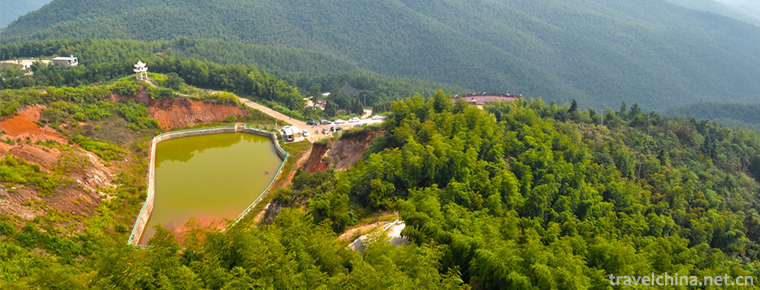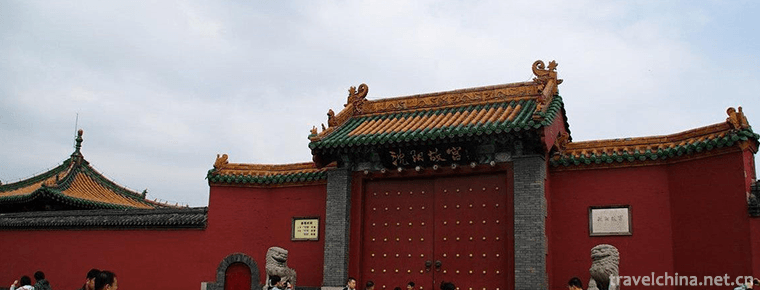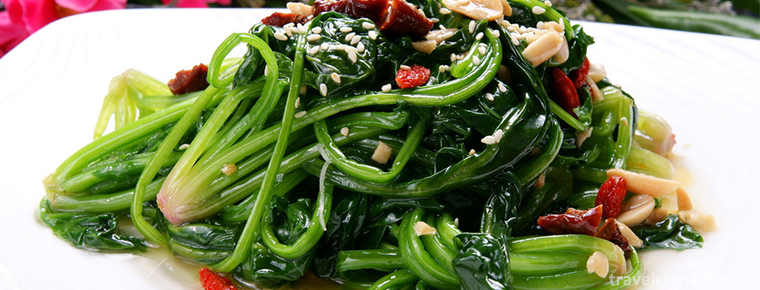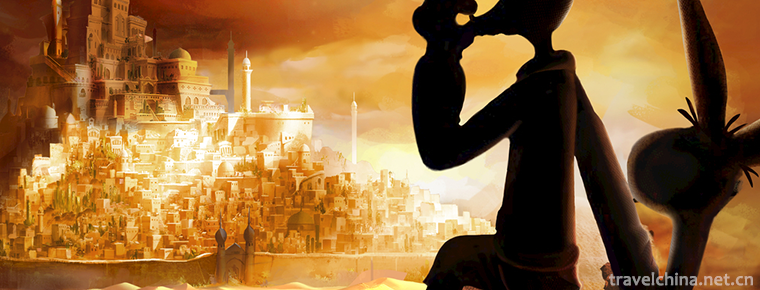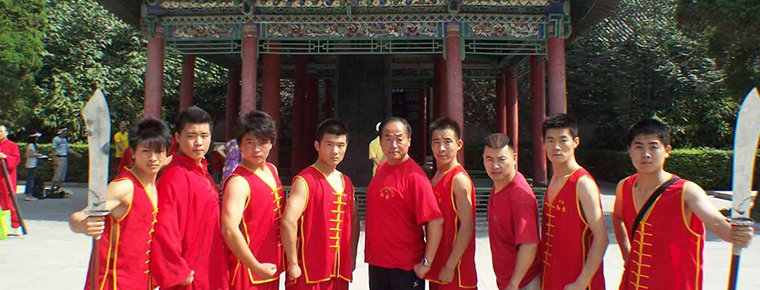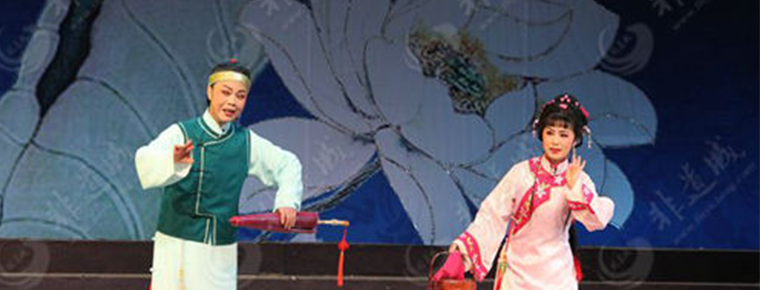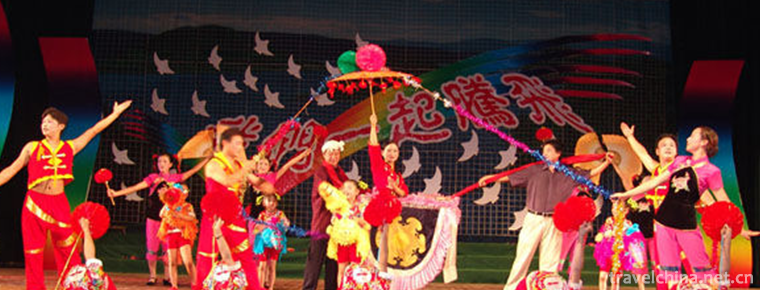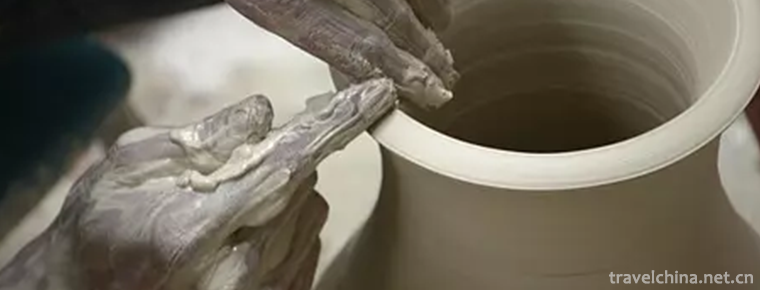Mingyue Gorge Scenic Area
Mingyue Gorge Scenic Area
Mingyue Gorge is located in the eastern section of Jialing Jiangxi Lingxia, Guangyuan, Sichuan Province. It covers an area of 6.1 square kilometers and is about 33 kilometers away from Guangyuan. Because the mountains and rocks on both sides of the Gorge are mostly silver-white and shine with the Qingfeng and the river, the whole Gorge River seems to be covered with a hazy moonlight, so it is named.
There are many strange peaks and rocks in the gorge: Tianzhu Peak, a magnificent and deep Huangpi Cave, clam pit called "the fourth spring of the world" by Tea Holy Lu Yu, fairy bridge flying over the sky, and Qingfeng "three knives" cutting clouds and fog.
geographical environment
Mingyue Gorge, also known as Chaotian Gorge, is located in Chaotian District, Guangyuan City, Sichuan Province. It is less than 2 hours'drive from Hanzhong, Shaanxi Province. It is an important part of Jianmen Shudao, a national scenic spot and a national key cultural relic protection unit. One of its characteristics is that it has six roads, namely, bird path, trestle path, waterway, highway and railway, in one Gorge. It can be called a natural "museum" of China's transportation. It also reflects Li Bai's "Shudao Difficulty".
Development history
Mingyue Gorge has a history of more than 2300 years. It is located in the northern part of Sichuan Province, at the junction of Sichuan, Shaanxi and Gansu provinces, and at the northern gate of Sichuan Province. It is the throat of entering and leaving Sichuan. It is known as Guangyuan City, known as "the important town of northern Shu", "the gateway of Northern Sichuan" and "the Golden Triangle of Bashu". Originally known as Chaotian Gorge, Chaotian Town was named after Chaotian Town. Chaotian means worshipping the Son of Heaven. When Emperor Xuanzong of the Tang Dynasty moved south to Chengdu to avoid the Anshi Rebellion, local officials received and worshipped there. Later, in the Ming and Qing Dynasties, literati and poets advocated nature, so they renamed Chaotian Gorge as Mingyue Gorge in the sense of Li Bai's poem "Qingfeng Qing, Mingyue Ming". But the local people still like to call it Chaotian Gorge as usual, so later there were many names, also called Chaotian Mingyue Gorge.
Chaotian Gorge is located on the Jialing River, about 30 kilometers north of Guangyuan, about 2 kilometers south of Chaotian District. It is about 4 kilometers long and about 100 meters wide. On both sides of the river, there are stone cliffs. To the East is the famous Chaotian Ridge, about 2 kilometers deep. It is a valley formed by the Jialing River breaking through mountains. Chaotian Gorge can be called the throat in the throat of Shu Dao. It is the only passage connecting the north and south. It has a precipitous terrain and unique advantages. For thousands of years, people have left six roads here in order to open Shu Dao, so people call it China.
The National Museum of Traffic History is an important place for studying ancient traffic in China. The six roads are:
1. In ancient times, the mountain people walked out of the sheep intestine path.
2. In the pre-Qin period, the government advocated the building of the trestle Road on the gorge wall.
3. Trackways built by boatmen along the Yangtze Gorge.
4. Shipway on Jialing River.
5. Sichuan-Shaanxi Highway built during the Republic of China.
6. Baocheng Railway Tunnel built in the 1950s opposite Sichuan-Shaanxi Highway.
Mingyue Gorge is known as China Road Traffic Museum and the living fossil of China Road Traffic Development. It has six ancient and modern roads, such as Pre-Qin Ancient Trestle Road, Jialing Waterway, Tracker Bird Road, Jinniu Yidao Road, 108 National Road and Baocheng Complex Line. Mingyuexia Ancient Trestle Road Site is the earliest excavation time in China so far, with the most scientific shape and structure, the largest number of holes, the best preserved and the most ancient trestle road style. It is now the provincial key cultural relics protection unit. Mingyue Gorge is magnificent and precipitous. Li Bai has the immortal poems of Shudao Difficulty. If you don't follow the ancient trestle road, you don't know the difficulty of Shu Road. Mingyue Gorge is an important part of Jianmen Shudao, a national scenic spot. Because of the importance of its terrain, many historical stories have occurred since ancient times, such as Xiaohe Langzhou Mingyue Gorge, Lijun Liufang Mingyue Gorge, Lu Youhun Mingyue Gorge, Zhang Xianzhongwei Town Mingyue Gorge, Wu Xiaoli Qingding Mingyue Gorge and so on.
The cultural tourism belt of Jianmen Shudao in Sichuan mainly includes: Chaotian Qipanguan - Mingyue Gorge - Qianfoya - Huangze Temple - Zhaohua Ancient City - Niutoushan - Tiantaishan - Jianzhao Ancient Post Road - Jianmen Gate - Cuiyun Corridor - Jianzhou Ancient City - Jueyuan Temple, with Mingyue Gorge Ancient Trestle Road, Zhaohua Ancient City, Jianmenguan and Cuiyun Corridor as the core.
Major attractions
One: Six Ways from Ancient to Modern
Chaotian Gorge can be called the throat of Shudao. It is the only passageway connecting the north and south. It has a precipitous terrain. For thousands of years, people have left six roads here in order to open Shudao. So it is also called the Museum of Traffic History of China. It is an important place to study ancient traffic in China. These six roads are: 1. The goat intestine path that the mountain people walked out of in ancient times. 2. In the pre-Qin period, the government advocated the building of the trestle Road on the gorge wall. 3. Trackways built by boatmen along the Yangtze Gorge. 4. Shipway on Jialing River. 5. Sichuan-Shaanxi Highway built during the Republic of China. 6. Baocheng Railway Tunnel built in the 1950s opposite Sichuan-Shaanxi Highway. Because of the importance of the terrain, many historical stories have happened since ancient times, such as Xiaohe Langzhou Mingyue Gorge, Lijun Liufang Mingyue Gorge, Lu Yousoul Mingyue Gorge, Zhang Xianzhongwei Town Mingyue Gorge, Wu Xiaoli Love Mingyue Gorge and so on.
Second: Chaotian Mingyue Gorge Ancient Trestle Road
Chaotian District also has Qingfengxia, Da'an Temple, Qipanguan, Qibiyi, Feixian Pavilion, Longmen Pavilion and other relics and scenic spots besides Mingyue Gorge. If you have time, you can visit them slowly one by one. Of course, the most important thing is the ancient Pavilion Road of Chaotian Mingyue Gorge. Ancient Trestle Road is located in Chaotian Mingyue Canyon and Laochuan-Shaanxi Highway passing through the canyon. There are only a few remains, many of which are post-repaired except for stone holes. Trestle Road, also known as Pavilion Road, was built by ancient people for the needs of life and war. Ancient Shu Road started in Chengdu, and after the steepness of Jianshan Mountain and Jianshan Mountain, it came to Chaotian Mingyue Gorge, where it really met the "road tiger". Ancient productivity is no way to build a safe road. If you want to go to Bashu, you must open this road. So the ancestors chiseled holes in the cliff wall and built a trestle road. It was not until the Northern and Southern Dynasties, when the Tang and Song Dynasties met, that people had difficulty in having the top of the cliff wall of Mingyue Gorge, and carved a goat intestine path along Chaotianling Mountain. However, because of the rugged mountain path and the dangerous slope, people were willing to choose a flat and nearer trestle road when they had to. During the Three Kingdoms Period, Zhuge Liang opened Jianmen Pavilion Road and renovated Mingyue Gorge Trestle Road to meet the needs of war. Only then did he get six stories of Qishan and Northern Expedition to the Central Plains. In the TV drama The Romance of the Three Kingdoms, the scene of burning the trestle road was filmed here. The danger of Mingyue Gorge can be seen from the difficulties of the construction of Sichuan-Shaanxi Highway by the government of the Republic of China in the 1930s. At that time, engineers and technicians tried to bypass Mingyue Gorge to find another way, but ultimately failed. They had to cut a grooved road along the cliff above the ancient trestle road of Mingyue Gorge with explosives and barely passed through the valley. Now the grooved highway still stays above Mingyue Gorge. It is the famous "tiger mouth" highway on the old Sichuan-Shaanxi road, which is quite spectacular and one of the highways in Sichuan-Shaanxi. This is why Li Bai's poems describe the difficulty of Shu Dao and the difficulty of going to Qingtian. Of course, social science and technology are no longer afraid of any road-blocking tigers. When mountains are opened and rivers are crossed, the new Sichuan-Shaanxi Expressway goes around the Mingyue Gorge and becomes a flat road. The Baocheng Railway also drills through the mountains above the Mingyue Gorge, while the ancient trestle road becomes a scenic spot for people to cherish the ancient times and hang on their ancestors. In addition to the ancient trestle road of Chaotian Mingyue Gorge, there is also a famous ancient trestle road in Shaanxi Province, namely the Shimen trestle road of the famous Jiaoguan ramp, which is located at the foot of Cuiyunping Mountain at the southern end of the Shimen Reservoir of Baogukou, 15 kilometers north of Hanzhong. The existing one was also restored in June 1996.
geographical environment
Mingyue Gorge is located in the north of Guangyuan City, about 30 kilometers south of Chaotian District 2 kilometers on the Jialing River. The whole length of the canyon is about 4 kilometers, and the width is about 100 meters. The two sides of the canyon stand on the rocky cliffs. To the East is the famous Chaotianling Mountains. The depth of the Canyon is about 1 kilometers. It is the canyon formed by the Jialing River breaking through the mountains. Mingyue Gorge can be called the throat of Shudao. It is the only way to connect the north and the south. It has a precipitous terrain and is endowed with unique advantages.
The Mingyue Gorge is 15 kilometers below Nanjin Pass, about 10 kilometers away. The rocks on both sides of the Strait are changeable and the waterfalls and springs are like the fairy world of Xianshan. Especially on the top of the elephant trunk hill on the South Bank of the Gorge, there are four strange stones, which stand out as bright as the shadow of a lamp. This is the famous Lantern Shadow Gorge far and near. These four rocks are very similar to the vivid images of Tang monks and apprentices returning from Buddhist scriptures. A Sun Wukong who seems to have opened the way, a pig like a horse crossing a mountain, a Tang like San Zang, like a palm sitting with a palm, is like a sand monk with shoulders and back. Guo Moruo wrote such a poem: "the monk of the Tang Dynasty, the head of the mountain, the shadow and the monkey" clearly defined the scenery of the Dengying gorge. On the North Bank of the upper end of the Lantern Shadow Gorge, Tianzhu Peak is like a pillar, rising to the heavens, rocky, ancient Musensensen. Xue Dong, a poet of the Ming Dynasty, once wrote poems describing Tianzhu Mountain Peak: "Roots come from nature without axes before the judgment of heaven and earth is reached." Winter snow freezes cold row of bamboo shoots, sunset flying clusters of golden lotus. Poor terraces are always flourishing and decaying, but Zishan is not the only place to live.
Tourist guide
Scenic area related service facilities:
There are parking lots, wharfs, tourist centers and other service facilities in the tourist area. Sightseeing bus: 10 yuan per person.
Diet:
At noon, we can have breakfast in Chaotian Street, mostly for farm dishes. It tastes good. When visiting Mingyue Gorge, there are usually Crispy Fish for sale here, 5 yuan for a small portion and 10 yuan for a large portion. When snacks are served with wine, they are very good.
When you visit Jianmen Pass, you must have a taste of Jianmen tofu. Jianmen tofu has a history of nearly 2000 years. Legend has it that in the six years of Jingyao in Shuhan, the Three Kingdoms (263), Jiang Wei, the general of Shu, was defeated and retreated to Jianmen to refuse to defend. Zhonghui and Deng Ai of Wei, generals of Shu, did their utmost to fight for this fortress. As a result of the continuous campaign, the soldiers in Jiangwei battalion were greatly reduced in strength, and the horses were exhausted due to fatigue, so it was difficult to fight any more. Some people offered plans to Jiangwei, ordering the soldiers to grind tofu, using tofu as their staple food, and feeding the soldiers and horses with bean dregs. The tofu grinded with Jianmen soybeans was not only delicate and refreshing, but also doubled after eating. Jiang Wei's soldiers and horses quickly recovered their physical strength, so they led the troops out of Guanguan and finally defeated Zhonghui and Deng Ai's army. Since then, the people around Jianmen have the habit of grinding tofu, and the reputation of tofu has gradually become a local specialty. Because the stone of Jianmen Mountain is hard, the granules are fine, the dregs of soybean milk are small, the amount of tofu is large, and the special sour vegetable water in Jiange area is used as brine, the tofu taste is unique, and it tastes very delicate and delicious.
Get accommodation:
guanyuan hotel
Located at No. 466 Shumen North Road, Guangyuan Bus Station, 1 km from Guangyuan Railway Station, 1 km from Shangxi Bus Station, 2 km from Nanhe Bus Station, 2 km from Chengmian Expressway Entrance and 5 km from Guangyuan Airport, the traffic is very convenient.
Address: 466 Shumen North Road, Guangyuan City.
Trestle Road Hotel
Located on the government road of Chaotian District, it is a newly renovated hotel according to two-star standard. It is rebuilt from the original Inn Road Hotel and covers an area of about 8000 square meters.
Address: Chaotian District Government Road.
Tourism Information
Best travel time
As Guangyuan is located in the transition zone from Qinba Mountains to Sichuan Basin, the terrain elevation varies greatly, and the surface temperature varies greatly with the elevation. Tourists should be prepared to cope with the three-dimensional climate. In addition, Guangyuan has a folk tradition of sacrificing Empress Wu Zetian on the 23rd of January every year. If visitors choose to travel in Guangyuan in spring and autumn, they can not only understand the Dragon Boat Race Temple Fair for sacrificing Wu Zetian, but also avoid the disastrous weather caused by the continuous summer and autumn rain in the same season.
Clothing supplies
Because the air is humid and the temperature difference between day and night is large, we must pay attention to rainproof and warm clothes.
Safety tips
Some sections of the ancient trestle road are relatively narrow. Be careful not to be crowded.
Traffic information
Arrive in Guangyuan
Aviation
Take a plane to Mianyang International Airport. Mianyang International Airport is 175 kilometers away from Guangyuan City. It takes about 2.5 hours to drive.
Beijing-Guangyuan Beijing has 11 direct flights to Mianyang International Airport. CA1451 of Air China takes off at 07:40 a.m. and arrives at 10:40 a.m.
Shanghai-Guangyuan Shanghai to Mianyang is Flight CA1451 of Spring and Autumn Airlines, which takes off at 14:50 p.m. and arrives in three hours.
On September 28, 2000, Guangyuan Panlong Airport was opened to navigation. In 2016, there have been roundtrip flights from Guangyuan to Beijing, Shanghai, Guangzhou, Shenzhen and Hangzhou.
Train
Guangyuan is located at the terminal of Baocheng Railway. There are only two trains, 6064 to Baoji and N757 to Chengdu. However, there are more than 40 trains per day from Guangyuan to Beijing, Shanghai, Chengdu, Xi'an, Kunming, Urumqi, Lhasa and Shenyang.
Beijing - Guangyuan Beijing West Railway Station has two trains arriving at Guangyuan Railway Station, which are about 200 yuan for T7 and K1363 hard seats respectively.
Shanghai-Guangyuan train k290 and K282 from Shanghai Railway Station run through 18 stations for 32 hours to Guangyuan, with a hard seat fare of 231 yuan.
Chengdu-Guangyuan from Chengdu, capital of Sichuan Province, to Guangyuan by train is very convenient, the shortest only takes 4.5 hours, hard seat fare 47 yuan.
On May 15, 2016, Chengdu to Guangyuan opened the EMU. In the past, it took more than five hours to take the general-speed train from Chengdu to Guangyuan, but now it only takes three and a half hours to take the EMU.
bus
From Guangyuan Long-distance Passenger Station, many buses are sent to other cities and counties in the province every day.
Self driving
It is a long way from Beijing, Shanghai and Guangzhou to Guangyuan. The road condition is complex and changeable, which is more suitable for fleet formation and line travel.
Arrive at Mingyue Gorge Scenic Area
Self driving >
Chengdu-Deyang-Mianyang-Guangyuan (lower highway of Guangyuan Lingjiang Toll Station) -Guangyuan City-Porcelain Kiln Pub Toll Station-Mingyuexia Toll Station-North Gate of Scenic Area Xi'an-Hanzhong-Huangbayi (Upper Second Special Line) -Chepanguan-Mingyuexia Toll Station-North Gate of Scenic Area
bus
Guangyuan Airport Station takes No. 12 to No. 2 Cotton Spinning Plant Station, No. 5 to Jianjian Road (Guangyuan Hotel) Station, Shangxi Railway Station, No. 1 or No. 15 to Jianjian Road (Guangyuan Hotel) Station.
Local traffic:
bus
Usually the first and last time is 6:00-19:00, the air-conditioning fare is 2 yuan, and the ordinary fare is 1 yuan.
Notes: Some cars here are unattended ticket cars. Please pay attention to the preparation of change.
Traffic jam: Guangyuan traffic is not very good, please pay attention not to travel in the morning and evening rush hours and holidays.
Taxi
Starting price: 4 yuan/2 km, kilometer price: 1 yuan/km
Notes: When getting off, please take your belongings with you and ask for the invoice.
Scenic Spot: Guanliangshan Temple, Jianmen







-
Zhongshan Zhan yuan
Zhanyuan is located in Beitai Village, South District of Zhongshan City, beside 105 National Highway, covering 100 mu. It is divided into three regions: Zhanyuan Zhushou, Qijiang Langqiao and Zhanfu Z.
Views: 212 Time 2018-12-22 -
Cai Lun Zhuhai
Cai Lunzhuhai is located in Huangshi Town and Dayi Town, Leiyang City, a famous historical and cultural city in central and southern China. It covers an area of 100 square kilometers and has a central.
Views: 111 Time 2019-01-04 -
Shenyang Palace Museum
The Shenyang Palace Museum, originally a royal palace built and used in the early Qing Dynasty, was built in 1625 (five years from tomorrow, ten years after the fate of the golden emperor)..
Views: 114 Time 2019-02-08 -
Spinach with Eight Delicacies
Babao spinach is a traditional Shandong dish, which belongs to Shandong cuisine. It is rich in color, bright, delicious, light and refreshing. In addition to spinach, Babao spinach is also equipped wi.
Views: 186 Time 2019-03-25 -
Avanti
Avanti, also translated by the Albanian side, (Uygur "Mr." means, Arabic: Juha or Nazar Ding), is a person active in Islamic nationalities from Morocco in the west to Xinjiang in China..
Views: 141 Time 2019-03-28 -
Red boxing
Red boxing originated in Zhou and Qin Dynasties, became famous in Tang and Song Dynasties and prevailed in Ming and Qing Dynasties. It is an important link.
Views: 180 Time 2019-05-03 -
Lake Opera
Huzhou Tanhuang, originally known as Huzhou Tanhuang, is a traditional local opera. It is mainly popular in Huzhou, Jiaxing, Yuhang and Linan of Hangzhou, Wujiang and Yixing of Jiangsu, Guangde of Anh.
Views: 119 Time 2019-05-03 -
Yangxin Tea Picking Opera
In May 2011, Gao'an City, Jiangxi Province, Linchuan District, Fuzhou City, Shaoguan City, Guangdong Province declared that tea-picking operas (Gao'an tea-picking opera, Fuzhou tea-picking opera, nort.
Views: 234 Time 2019-07-10 -
Celadon Firing Techniques of Yue Kiln
The firing history of celadon in Yue kiln has gone through the firing process of primitive, primitive and mature ceramics kilns and mature ceramics kilns (i.e. ceramics kilns). In the firing process, .
Views: 140 Time 2019-07-16 -
Beijing Language and Culture University
Beijing Language and Culture University, established in 1962 under the personal care of Premier Zhou Enlai, is a university directly under the Ministry of Education of China. In June 1964, it was name.
Views: 214 Time 2019-09-22 -
Huainan Normal University
The school was founded in 1958 when it was a teacher's College in Huainan. In 2000, approved by the Ministry of education, the former Huainan normal school, Huainan Education Institute and Huainan nor.
Views: 225 Time 2019-11-16 -
Historical evolution of Yibin
In the sixth year of Jianyuan (135 B.C.), Emperor Wu of Han Dynasty established Qianwei County, and at the beginning of the county administration, he (the west of Zunyi City, Guizhou Province) was established. In the first year of the first Yuan Dynasty of emperor Z.
Views: 375 Time 2020-12-18

